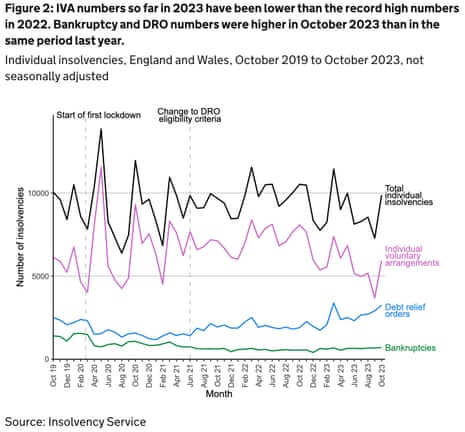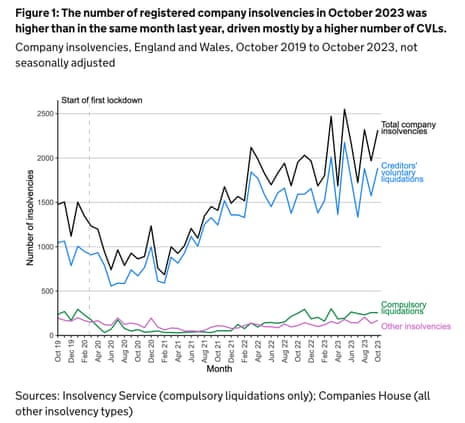Insolvencies jump 18% in England and Wales as high interest rates hit firms – business live | Business
Insolvencies up 18% in October
Newsflash: the number of companies falling into insolvency in England and Wales has jumped again.
There were 2,315 registered company insolvencies in October, which is 18% higher than in October 2022 (when there were 1,954), a worrying sign for the UK economy as it enters the winter.
It’s also an 18% increase on a monthly basis, as there were 1,969 insolvencies in September.
UK companies have been hit by high interest rates, and weak consumer spending as households have been hit rising prices.
The increase in company insolvencies was driven mostly by Creditors’ Voluntary Liquidations (CVLs) in which company directors opt to wind up an insolvent company which has no prospect of recovery.
There were 256 compulsory liquidations, 1,889 creditors’ voluntary liquidations (CVLs), 146 administrations, 23 company voluntary arrangements (CVAs) and one receivership appointment, the Insolvency Service says.
Compulsory liquidations, CVLs, CVAs and administrations were all higher than in October 2022.
David Hudson, restructuring advisory partner at business advisory firm FRP, says:
“Inflated input costs and higher interest rates have pushed many firms over the edge in recent weeks. However, this data is the result of pressure built up in businesses over months and years, so the likelihood is that we haven’t seen the true extent of this wave of insolvencies yet.
Hudson adds that management teams will need to keep a close eye on signs of distress in their supply chains.
Rising insolvencies increases the risk of a knock-on effect in supply chains that could, in the worst cases, pull them under too.”
Key events
The UK’s Serious Fraud Office has carried out a series of dawn raids and arrests in connection with the collapse of law firm group Axiom Ince.
The SFO arrested seven individuals and raided nine sites around Bedfordshire on Tuesday morning, the Financial Times reports, as it announced a formal investigation into allegations of fraud at Axiom and £66mn of missing client money.
The SFO’s action comes almost seven weeks after British police launched a criminal investigation into Axoim, which admitted in mid-September that £64m of client money has largely disappeared, seemingly used to fund several takeovers.
In August, three Axiom Ince directors were suspended by the Solicitors Regulation Authority.
SFO director Nick Ephgrave, who began his role in September, has told the FT that the operation highlighted a new approach to investigations under his leadership.
Ephgrave says:
“We accepted the investigation on September 5 and a few weeks later we’re going through doors, gathering evidence and making arrests, and that’s the kind of approach I’m encouraging here.”
We have “gone from flash to bang quite quickly”, he added.
In the currency markets, the rouble has hit its highest level against the US dollar since August.
Russia’s currency strengthened to 90.6 roubles to the dollar, extending a recent rally since the start of October (when the rouble weakened through 100 to the dollar).
The rouble has benefited from recent interest rate increases, as Russia’s central bank has tried to support the currency.
Moscow has also imposed additional currency control, restricting western companies that sell their Russian assets from taking the proceeds in dollars and euros, which also helped the rouble.
Bus workers to strike, but BBC dispute resolved
Bus workers are to stage a series of strikes in a dispute over pay.
Members of the Rail, Maritime and Transport union (RMT) at Stagecoach East Midlands will walk out for 48 hours from November 27 and for the same period from December 4, 11 and 18 after voting in favour of industrial action.
RMT general secretary Mick Lynch said:
“The huge endorsement for strike action by our Stagecoach members reflects the growing disgust among bus workers at being taken for granted while their pay continues to fall in real terms.
“Management need to come up with a reasonable offer that deals with the poverty pay and poor conditions in the industry.
“However, if Stagecoach bosses remain intransigent, our members are fully prepared to take further industrial action on and into the new year if necessary.”
But peace has broken out at the BBC, where journalists have voted overwhelmingly to accept a deal on jobs and programming, ending a long-running dispute.
Members of the National Union of Journalists (NUJ) in BBC Local backed the deal by 70% after previously taking industrial action.
Paul Siegert, NUJ broadcasting organiser, said:
“This is an overwhelming result in our long-running dispute at BBC Local. We’ve gained significant safeguards on jobs and income protection for NUJ members, along with new concessions on radio news bulletins and shared programming.
Here’s Georgia Quenby, Partner at City law firm Fladgate, on today’s insolvency data:
The October 2023 insolvency statistics show a continuation of the post-pandemic trend of a significant increase in the numbers of CVLs, a doubling of the number of CVAs from 11 to 23 and a further increase in administrations from 125 to 146 as against September 2022.
For context, these 23 CVAs represent more than 4 times as many CVAs than October 2022. At 146, the number of company administrations is 36% higher than October 2022, but this is a slight slowing of the rate of increase in administrations bringing the curve much more into line with historic averages.
The CVLs are likely to reflect a continuing “clear-out” of small businesses which have ceased trading across a whole range of sectors. But the increase in CVAs and administrations bringing the numbers more in line with 2019 and prior years is probably reflective of the continued availability of new money to support businesses which can be restructured and continue trading.
The ‘slow crush’ of persistently high interest rates are pushing businesses of all kinds to the point of failure, say Alex Jay and Tim Symes, partners at law firm Stewarts.
As the latest statistics from The Insolvency Service reveal that registered company insolvencies in October 2023 were 18% higher than in the same month in 2022, partners Alex Jay and Tim Symes analyse the challenges facing the economy.
Read more here: https://t.co/JYFIJIQPH3
— Stewarts (@StewartsLawLLP) November 14, 2023
Although business insolvencies are climbing, personal insolvencies dropped last month.
The Insolvency Service reports that there were 9,881 individual insolvencies across England and Wales in October.
That is 6% lower than in October 2022, although an increase on September when 7,280 personal insolvencies were filed.

Joanne Wright, managing director at Kroll, says these personal insolvency statistics are “an ongoing conundrum”.
Despite the spike in interest rates and the ongoing cost of living crisis, the overall numbers are declining which is not what anyone would expect to see.”
“The one understandable statistic is the sharp incline in debt relief orders. Borrowers with no assets and debt levels of less than £30,000 seem to be using this procedure instead of Individual Voluntary Arrangements (IVAs). This could be seen as a positive step as there have recently been some questions around how appropriate IVAs are for smaller borrowers.”
Businesses are being “battered from all sides”, warns Nicky Fisher, President of R3, the UK’s insolvency and restructuring trade body.
Following the rise in insolvencies, Fisher explains:
Costs have increased, demands for wages are incoming and people are spending less as they look to save ahead of the winter and to make sure they have enough left to cover the basics.
If the Christmas trading period doesn’t bring a wave of new income, we could see insolvencies continue to rise in the new year, and at the moment, it’s impossible to predict whether this will be a badly needed boost or the final blow for struggling firms.
The pressure on small businesses right now is off the scale, so the massive jump in insolvencies, up 18% in October, isn’t surprising.
Next week’s #AutumnStatement must deliver for small businesses, the backbone of the economy. There is no time to waste. https://t.co/bD6KN6JTYg
— Candy Richards (@FSBEastAnglia) November 14, 2023
Samuel Mather-Holgate, independent financial advisor at Mather and Murray Financial, blames the government and the Bank of England for the rise in insolvencies:
The legacy of Sunak won’t be halving inflation, it will be the pain and suffering he and Andrew Bailey have inflicted on British households.
The amount of people and businesses unable to cope with rising levels of debt and higher interest is yet to be seen, but these figures indicate how rapidly things are turning bad.
Rishi Sunak may be able to declare victory in his pledge to halve inflation this year tomorrow, when the latest inflation data is released.
We have confirmation that the eurozone is halfway into recession.
GDP across the single currency region fell by 0.1% in July-September, new data released by statistics body Eurostat shows. That matches the first estimate released at the end of October.
The data confirms that the German economy shrank by 0.1% in July-September, while France grew by 0.1% and Italy stagnated.
If the eurozone shrinks in the current quarter (October-December), then the eurozone would be in a technical recession.
The UK economy, for contrast, didn’t grow in the quarter.
David Kelly, Head of Insolvency at PwC, says smaller companies are bearing the brunt of the rise in insolvencies in England and Wales last month.
“Continuing supply chain pressures, energy costs, inflation and the high cost of debt mean that many corporate balance sheets remain fragile – particularly those of smaller owner-managed companies. These continue to bear most of the pain, with 98% of insolvencies in October being for companies with turnover of less than £1 million.
“Although there was a 58% increase in companies with more than £1 million turnover going into an insolvency process in October 2023 compared with October 2022, the numbers are still relatively low, with less than 50 companies filing for an insolvency process in this turnover range. Engineering, business services, and hospitality and leisure continue to be the sectors facing the most pressure, with 70% of insolvencies coming from these four sectors.
“Looking ahead, unfortunately we expect the number of insolvencies to remain high in the final months of this year, with no sector immune from the prevailing external challenges.”
The jump in insolvencies last month is sparking more calls for Jeremy Hunt to help businesses, in next week’s autumn statement
Nick O’Reilly, director of restructuring and recovery at accountancy firm MHA, says the chancllor should introduce an overhaul to business rates and policies to stem spiralling insolvencies:
“The government must act swiftly to stem the rising tide of insolvencies and stimulate growth. The current plight of hospitality and retail businesses demands urgent government intervention through a comprehensive overhaul of the business rate system.
The government must create a system that is based on turnover rather than property values. A minimum fixed rate that increases based on turnover would mean that retailers and local authorities would both be winners when a business does well and ensure they are not overburdened in downturns.
“HMRC also desperately requires increased funding to streamline its financial debt recovery processes. The existing Time to Pay system is a postcode lottery as to whether a firm will secure an agreement to repay its debts or face a winding up petition. Businesses need a more cohesive approach from HMRC so they have greater certainty when it comes to managing finances.
To stimulate growth, a multifaceted approach is needed. This should include the reduction of red tape on exports, lowering interest rates and implementing a tax stimulus. Businesses yearn for policies that instil hope and foster a conducive environment for sustained growth. It is high time the government implemented measures that resonate with the needs of businesses and propel the economy forward.”
Insolvencies up 18% in October
Newsflash: the number of companies falling into insolvency in England and Wales has jumped again.
There were 2,315 registered company insolvencies in October, which is 18% higher than in October 2022 (when there were 1,954), a worrying sign for the UK economy as it enters the winter.
It’s also an 18% increase on a monthly basis, as there were 1,969 insolvencies in September.
UK companies have been hit by high interest rates, and weak consumer spending as households have been hit rising prices.
The increase in company insolvencies was driven mostly by Creditors’ Voluntary Liquidations (CVLs) in which company directors opt to wind up an insolvent company which has no prospect of recovery.
There were 256 compulsory liquidations, 1,889 creditors’ voluntary liquidations (CVLs), 146 administrations, 23 company voluntary arrangements (CVAs) and one receivership appointment, the Insolvency Service says.
Compulsory liquidations, CVLs, CVAs and administrations were all higher than in October 2022.

David Hudson, restructuring advisory partner at business advisory firm FRP, says:
“Inflated input costs and higher interest rates have pushed many firms over the edge in recent weeks. However, this data is the result of pressure built up in businesses over months and years, so the likelihood is that we haven’t seen the true extent of this wave of insolvencies yet.
Hudson adds that management teams will need to keep a close eye on signs of distress in their supply chains.
Rising insolvencies increases the risk of a knock-on effect in supply chains that could, in the worst cases, pull them under too.”
IEA raises oil growth forecasts
In the energy sector, the International Energy Agency (IEA) has raised its oil demand growth forecasts for this year and next.
In its latest monthly report, the IEA says world oil demand continues to exceed expectations, although demand growth could slow next year.
It says:
In this Report, we have slightly revised up our 2023 growth forecast to 2.4 million barrels per day (mb/d), as US deliveries proved more resilient than indicated by preliminary data and Chinese oil demand in September set another all-time high above 17 mb/d, fuelled by a booming petrochemical sector.
Global oil demand is set to rise to a record annual high of 102.9 mb/d in 2024, the IEA estimates, even though there are signs of weaker growth in major economies.
Demand is expected to fall in the OECD next year.
On the production side, the IEA says world oil supply is “firmly on an upward trajectory”, adding:
World oil supply growth is also exceeding expectations. Fears that the war between Israel and Hamas would escalate into a wider regional conflict, disrupting oil supply flows, have yet to materialise.
But the IEA warns that the oil market could experience more volatility, saying:
With demand growth set to slow, the market could shift into surplus at the start of 2024.
For now, with demand still exceeding available supplies heading into the Northern Hemisphere winter, market balances will remain vulnerable to heightened economic and geopolitical risks – and further volatility ahead.
There’s little in today’s jobs report to encourage the Bank of England to change interest rates, higher or lower, argues Martin Beck, chief economic advisor to the EY ITEM Club.
Beck explains:
The latest labour market release signalled a stable UK jobs market. The jobless rate was unchanged from Q2 to Q3 and while pay growth slowed a little, it was still strong by past standards.
But judging what the data means for monetary policy isn’t clear cut.
On the quantities side, today’s release was again lacking the usual Labour Force Survey (LFS) data. And the Monetary Policy Committee (MPC) has been sceptical about the story told by the official pay series, although the latest numbers are more in line with other measures. But overall, labour demand and pay growth appear to be cooling, albeit only slowly, consistent with interest rate cuts not being on the agenda for a while yet.
NIESR, the economic research institute, predicts that wage growth will remain historically elevated in the final quarter of this year.
Paula Bejarano Carbo, associate economist at NIESR, says:
“Average weekly earnings, excluding bonuses, grew by 7.7 per cent in the third quarter of 2023 and by 7.9 per cent if we include bonuses – though the latter figure is affected by one-off civil service bonus payments.
While both figures remain high relative to their respective historical average growth rates of 3.2 and 3.1 per cent, when we adjust for inflation, today’s figures drop to 1.3 and 1.4 per cent, highlighting the extent to which elevated inflation continues to harm households.
Today’s experimental data suggest that the UK unemployment rate was largely unchanged on the quarter at 4.2 per cent, while vacancies fells by 58,000 in the three months to October; these data indicate that the labour market continues to loosen at a slow pace, leading us to expect that wage growth will remain historically elevated in Q4.”



